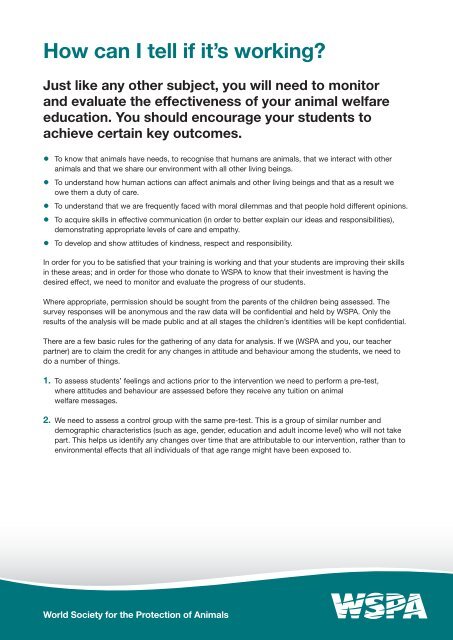WSPA - First Concepts: for teachers
WSPA - First Concepts: for teachers
WSPA - First Concepts: for teachers
You also want an ePaper? Increase the reach of your titles
YUMPU automatically turns print PDFs into web optimized ePapers that Google loves.
How can I tell if it’s working?Just like any other subject, you will need to monitorand evaluate the effectiveness of your animal welfareeducation. You should encourage your students toachieve certain key outcomes.• To know that animals have needs, to recognise that humans are animals, that we interact with otheranimals and that we share our environment with all other living beings.• To understand how human actions can affect animals and other living beings and that as a result weowe them a duty of care.• To understand that we are frequently faced with moral dilemmas and that people hold different opinions.• To acquire skills in effective communication (in order to better explain our ideas and responsibilities),demonstrating appropriate levels of care and empathy.• To develop and show attitudes of kindness, respect and responsibility.In order <strong>for</strong> you to be satisfied that your training is working and that your students are improving their skillsin these areas; and in order <strong>for</strong> those who donate to <strong>WSPA</strong> to know that their investment is having thedesired effect, we need to monitor and evaluate the progress of our students.Where appropriate, permission should be sought from the parents of the children being assessed. Thesurvey responses will be anonymous and the raw data will be confidential and held by <strong>WSPA</strong>. Only theresults of the analysis will be made public and at all stages the children’s identities will be kept confidential.There are a few basic rules <strong>for</strong> the gathering of any data <strong>for</strong> analysis. If we (<strong>WSPA</strong> and you, our teacherpartner) are to claim the credit <strong>for</strong> any changes in attitude and behaviour among the students, we need todo a number of things.1. To assess students’ feelings and actions prior to the intervention we need to per<strong>for</strong>m a pre-test,where attitudes and behaviour are assessed be<strong>for</strong>e they receive any tuition on animalwelfare messages.2. We need to assess a control group with the same pre-test. This is a group of similar number anddemographic characteristics (such as age, gender, education and adult income level) who will not takepart. This helps us identify any changes over time that are attributable to our intervention, rather than toenvironmental effects that all individuals of that age range might have been exposed to.World Society <strong>for</strong> the Protection of Animals
















